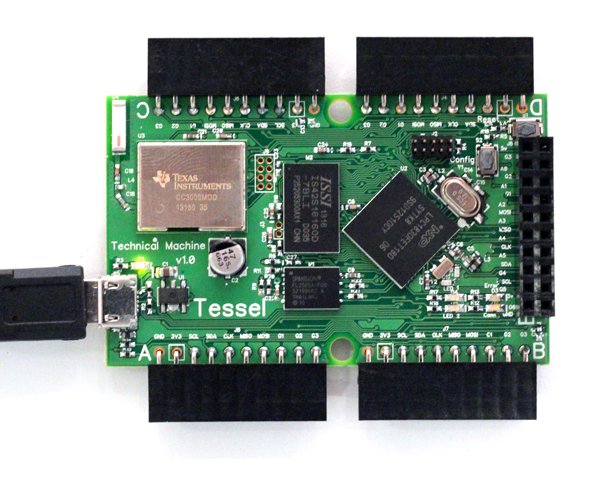People who are proficient with JavaScript or web technologies may not be completely comfortable with programming MCU in assembler and/or C programming language. Node.js, written in JavaScript, seems to be quite popular this days for diverse projects, but technical.io has decided to design a board called Tessel, powered by a Cortex M3 MCU. that can be fully programmed with JavaScript/Node.js.
Tessel hardware specifications:
- MCU – NXP LPC1830 ARM Cortex-M3 @ 180mhz
- System Memory – 32MB SDRAM
- Storage – 32MB Flash
- Connectivity – Wi-Fi via TI CC3000
- Expansion – 16-pin GPIO bank for prototyping
- Power – Micro USB or battery
The board is said to be compatible with 1000’s of Node.js modules from NPM, can be programmed via USB or Wi-Fi using your own IDE, and support Tessel modules, as well as Arduino Shields.
There are two (price) classes for Tessel modules:
- Class A:
- Relay — turn devices on and off (up to 5 amps)
- Temperature/Humidity sensor — get information about the climate
- Servo Driver – make up to 16 little motors move. Includes one servo. (Additional power supply included for US backers)
- Accelerometer — get real-time movement data
- MicroSD Storage — add extra storage to your Tessel (includes a 1GB microSD card)
- Class B:
- RFID (13.56MHz) — read RFID tags
- Bluetooth Low Energy — send data to other devices, i.e. smartphones
- GPS — get location information
- Audio Output — decode and output sound files / raw audio
You can find hardware documentation, JavaScript libraries and sample code in the company’s github repo.
The company is looking for funds for mass production on Dragon Innovation, a new crowdfunding platform, and has already received over $100,000 in pledges. $99 will get your the Tessel board and a Class A modules, whereas $124 is good for the Tessel board and a Class B module. Shipping is expected for February 2014. You can find further information and/or pledge on their campaign page.

Jean-Luc started CNX Software in 2010 as a part-time endeavor, before quitting his job as a software engineering manager, and starting to write daily news, and reviews full time later in 2011.
Support CNX Software! Donate via cryptocurrencies, become a Patron on Patreon, or purchase goods on Amazon or Aliexpress





